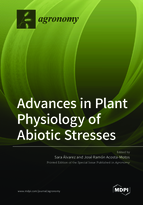Advances in Plant Physiology of Abiotic Stresses
A special issue of Agronomy (ISSN 2073-4395). This special issue belongs to the section "Horticultural and Floricultural Crops".
Deadline for manuscript submissions: closed (25 July 2022) | Viewed by 29481
Special Issue Editors
Interests: deficit irrigation; plant physiology; ornamental plants; stress physiology; evapotranspiration; salinity; water relations; tree nut crops; intrinsic water use efficiency
Special Issues, Collections and Topics in MDPI journals
Interests: plant physiology; stress physiology; abiotic stress; salinity; antioxidative metabolism; water saving strategies; postharvest technology; ornamental plants; rice; fruit trees
Special Issues, Collections and Topics in MDPI journals
Special Issue Information
Dear Colleagues,
Plant stress could be defined as any unfavourable condition or substance that can affect or block the metabolism, growth and development of a plant. The response of the plant may vary depending on the frequency and intensity of the stress situation as well as the developmental stage of the plant.Plants, throughout their life cycle, are exposed to a large number of conditions or stressors. Abiotic stress is stress caused by non-living agents. Depending on the nature of the causal agent, it can be divided into physical and chemical. Physical (actually, physical-chemical) stresses include water deficit, salinity (in its osmotic component), temperature extremes (heat, cold, freezing), excessive or insufficient irradiation, anaerobiosis caused by waterlogging or flooding, mechanical stress caused by wind or excessive soil compaction, and stress induced by wounds or injuries. Chemical stress is caused by salinity (in its ionic or toxic component), by the lack of mineral elements and by environmental pollutants such as sulphur dioxide (SO2), nitrogen oxides (NOx), chlorofluorocarbon compounds (CFCs), ozone (O3) and metals.
What do all stresses have in common? The damage caused by various stresses is partly mediated by an overproduction of reactive oxygen species (ROS). Furthermore, these stresses affect plant physiology through changes in photosynthesis, respiration or carbohydrate metabolism.
Probably the abiotic stresses that most negatively affect growth and production are drought, salt stress and temperature stress (high and low temperatures), all of which are associated with climate change.
This Special Issue will focus on “Advances in Plant Physiology of Abiotic Stresses”. We welcome novel research, reviews, and opinion pieces covering all related topics indicated above on how plants respond to physical and chemical stresses associated with abiotic stress in a context of climate change.
Dr. Sara Álvarez
Dr. José Ramón Acosta-Motos
Guest Editors
Manuscript Submission Information
Manuscripts should be submitted online at www.mdpi.com by registering and logging in to this website. Once you are registered, click here to go to the submission form. Manuscripts can be submitted until the deadline. All submissions that pass pre-check are peer-reviewed. Accepted papers will be published continuously in the journal (as soon as accepted) and will be listed together on the special issue website. Research articles, review articles as well as short communications are invited. For planned papers, a title and short abstract (about 100 words) can be sent to the Editorial Office for announcement on this website.
Submitted manuscripts should not have been published previously, nor be under consideration for publication elsewhere (except conference proceedings papers). All manuscripts are thoroughly refereed through a single-blind peer-review process. A guide for authors and other relevant information for submission of manuscripts is available on the Instructions for Authors page. Agronomy is an international peer-reviewed open access monthly journal published by MDPI.
Please visit the Instructions for Authors page before submitting a manuscript. The Article Processing Charge (APC) for publication in this open access journal is 2600 CHF (Swiss Francs). Submitted papers should be well formatted and use good English. Authors may use MDPI's English editing service prior to publication or during author revisions.
Keywords
- abiotic stresses
- environmental stress
- physical stress
- water deficit
- salinity
- extreme temperatures
- excessive or insufficient irradiation
- lack of oxygen
- waterlogging
- flooding
- mechanical stress
- stress induced by wounds or injuries
- Chemical stress
- self-defence mechanisms







